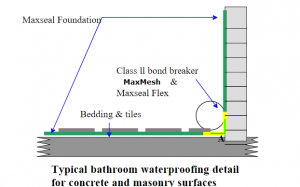waterproofing pros are the experts of keeping your bathroom leak-free and looking great. Whether you are installing a new bathroom, replacing an old one, or just updating your existing one, waterproofing is an essential step in ensuring that your bathroom remains dry. In this guide, we’ll take a look at why bathroom waterproofing is important, what the different types of waterproofing materials are, and how you can help ensure that your bathroom stays watertight.
What Is Waterproofing?
Bathroom waterproofing is a process that prevents water from penetrating into and damaging the structure of your bathroom. Different types of materials are used for bathroom waterproofing, including polyurethane sealants, liquid membranes, and self-adhesive tapes. Each of these materials has its own unique set of properties and benefits, making them useful for specific applications and needs.
Why is Waterproofing Important?
Waterproofing your bathroom is essential for preserving the integrity of the walls, floors and ceilings. Without proper waterproofing, serious problems can occur like mould, mildew, and water damage to your walls and floors. Not only can this create an unsightly mess, it can also be a health hazard if not addressed promptly.
In addition, properly sealed surfaces make it easier to keep your bathroom clean and hygienic. This is because liquid and moisture are less likely to seep through and cause staining and discoloration on the walls and floors.
Types of Waterproofing Materials
There are several different types of materials that are used for waterproofing bathrooms:
- Polyurethane sealants are highly effective waterproofing agents which create a protective barrier between the wall and floor. They are also long lasting and resistant to chemicals and abrasives.
- Liquid membranes are typically applied over existing surfaces to form a durable, waterproof layer. They are often used in conjunction with other waterproofing products to provide additional protection.
- Self-adhesive tapes are an easy and cost-effective way to waterproof small areas, such as shower stalls and around plumbing fixtures. While they are not as durable as polyurethane sealants or liquid membranes, they can provide adequate protection for many areas.
It’s important to choose the right waterproofing product for your particular needs. For best results, consult with an experienced professional waterproofing specialist who can determine the best solution for your bathroom.
How to Achieve a Waterproof Bathroom
Achieving a truly waterproof bathroom requires careful consideration and preparation. Here are some tips to help ensure that your bathroom remains watertight:

- Clean and repair any cracks, chips, or other damage in the walls and floors before waterproofing.
- Use the appropriate waterproofing material for the area being treated.
- Ensure that all seams and joints are properly sealed.
- Reapply waterproofing materials when necessary to maintain their effectiveness.
- Test areas as you go to ensure that there are no leaks.
Finally, it’s important to remember that waterproofing is only part of the equation when it comes to protecting your bathroom from water damage. Regular maintenance and cleaning are also necessary for maintaining a healthy and attractive bathroom.
Conclusion
Bathroom waterproofing is an essential component in protecting your home from water damage. With the right materials and careful application, it is possible to achieve a waterproof bathroom that will last for years to come. Follow these tips and be sure to consult with an experienced professional to ensure that your bathroom is protected against water damage.
